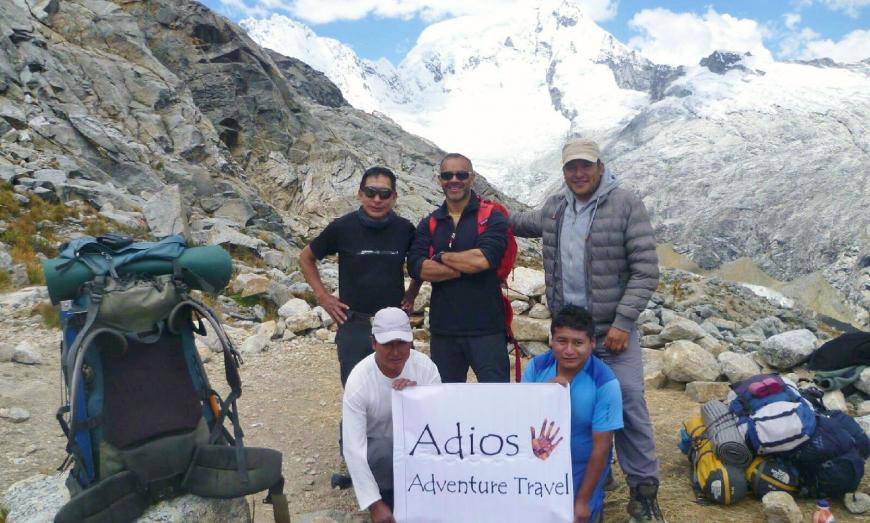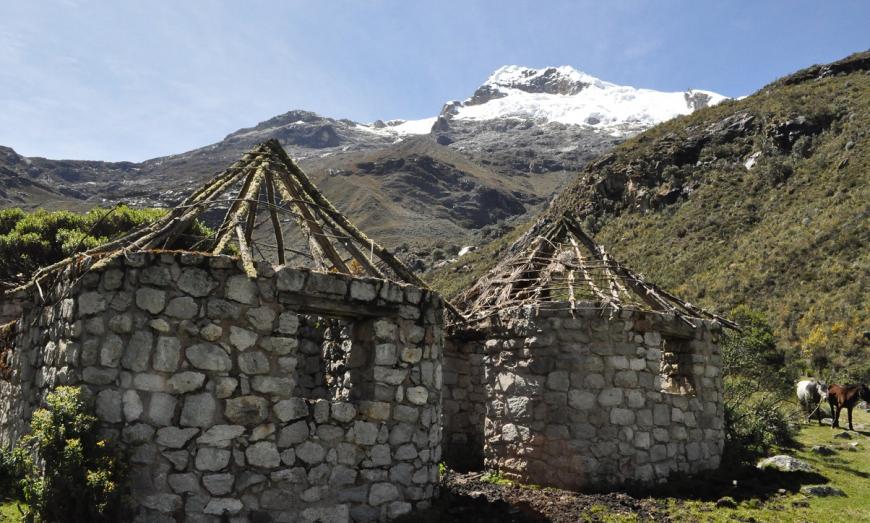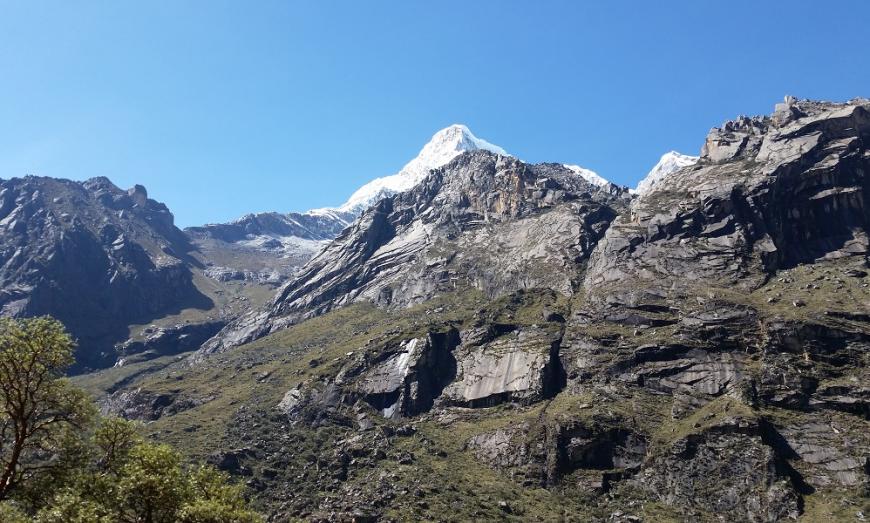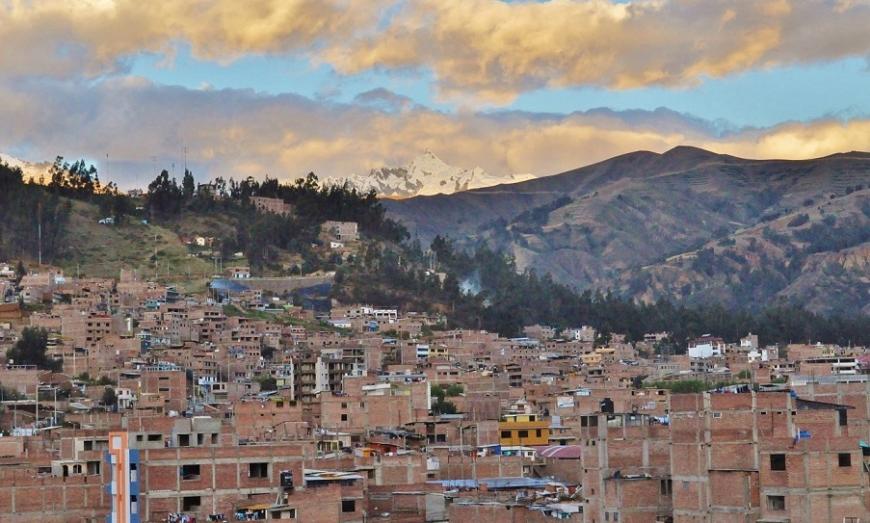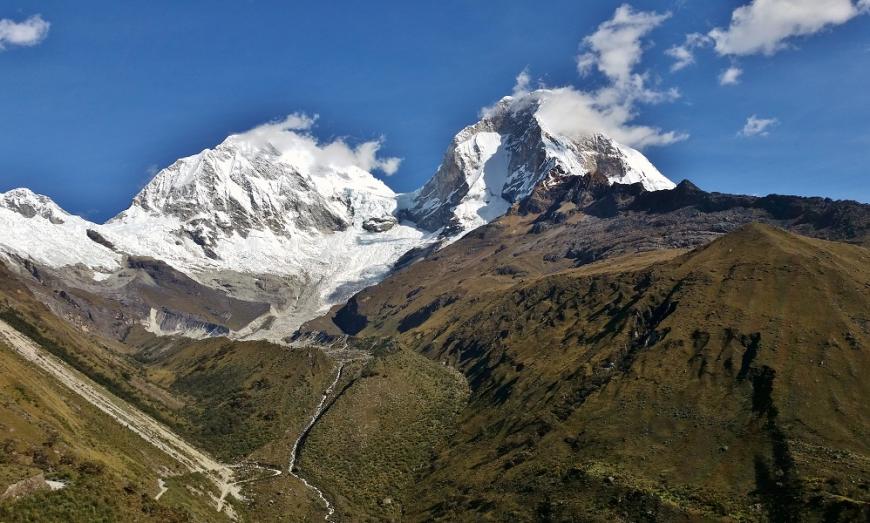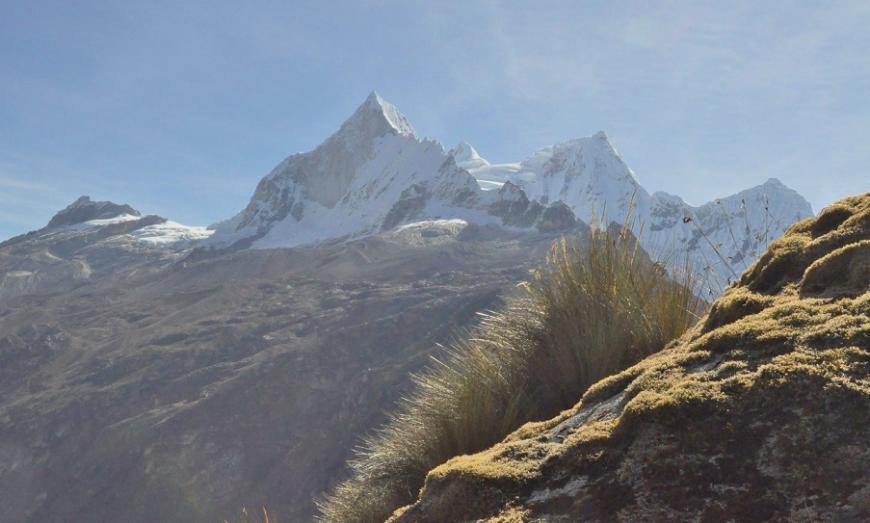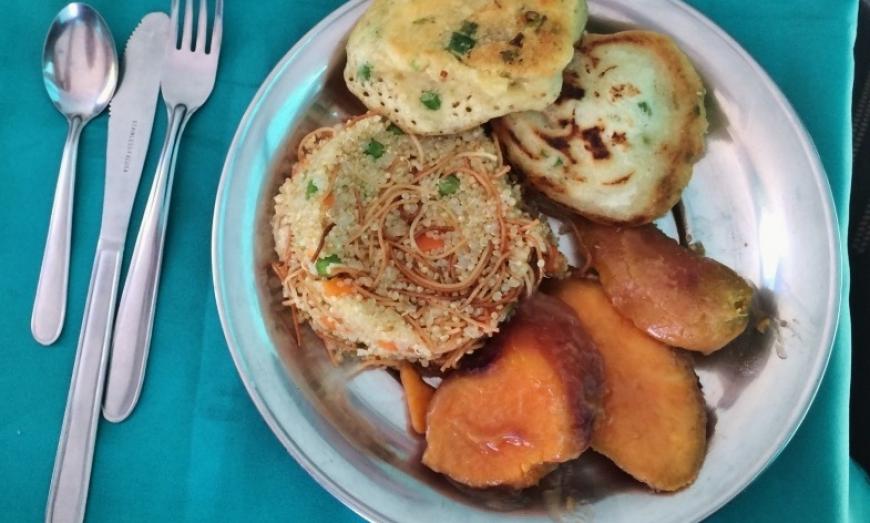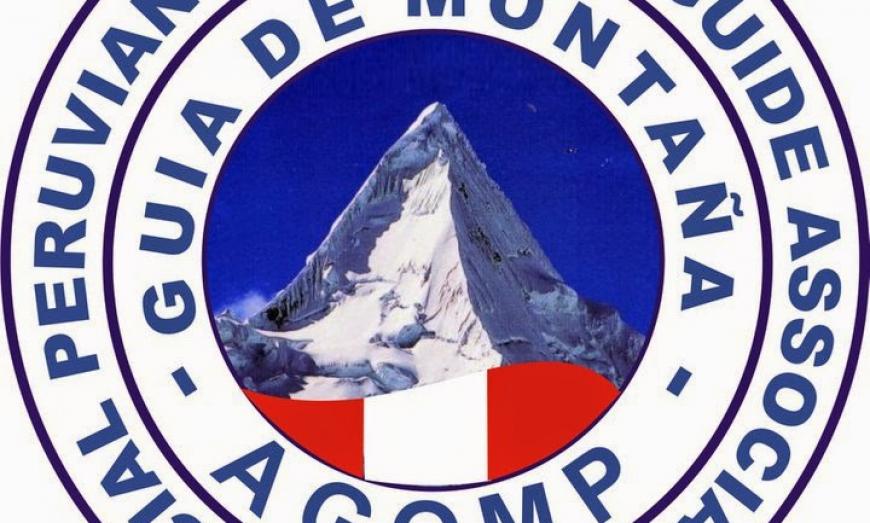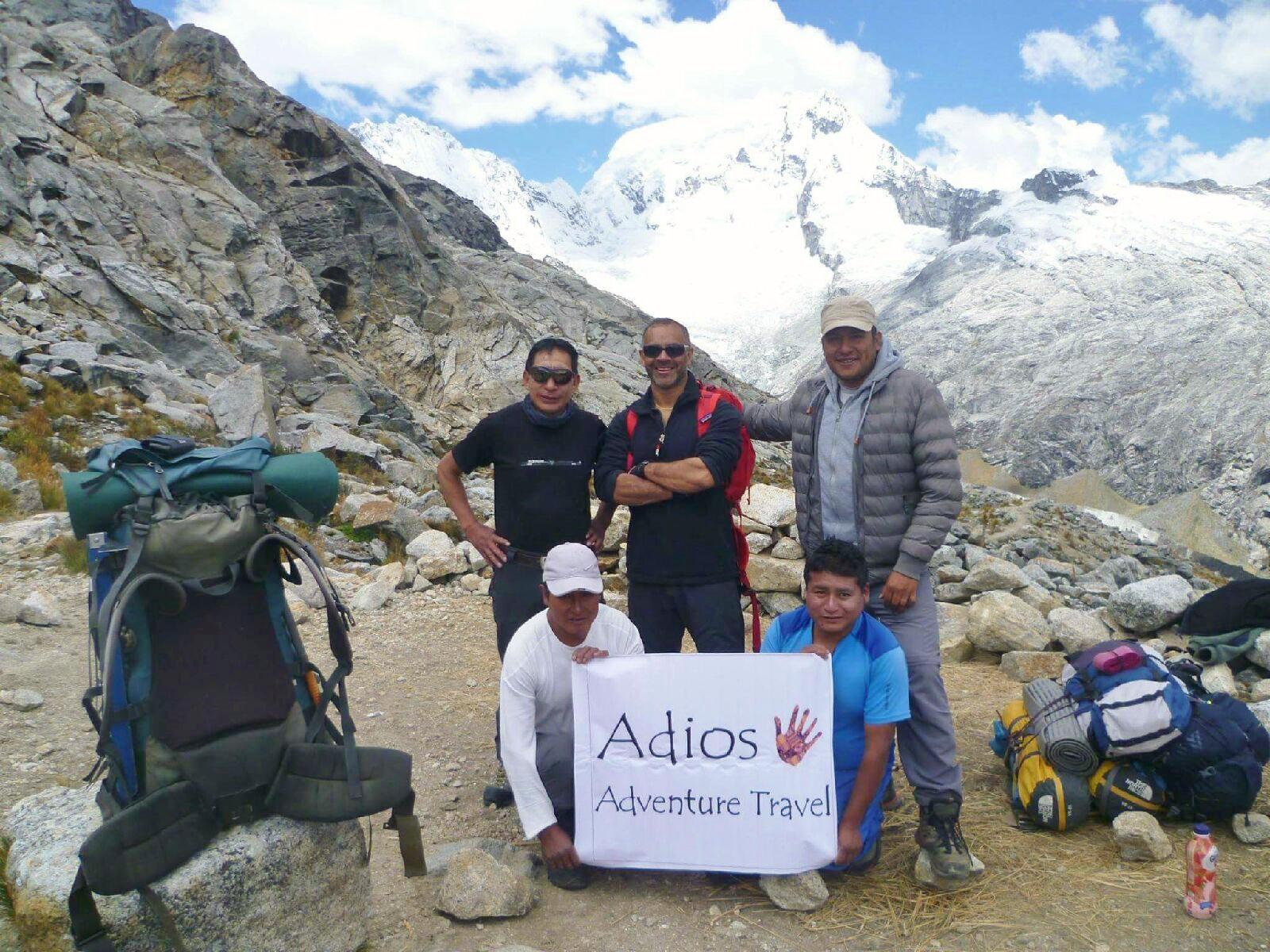
Please send me information about this trip
Day 1: Fly Lima - Huaraz 3090m
Check in 4 am for early flight departing Lima at 05:30 AM. Arriving Huaraz by 07:15 AM Transfer to hotel for checkin. Breakfast followed by rest. Afternoon walk around the town. Dinner in restaurant of your choice.
Day 2: Acclimatization day – Hike Churup Lake 4460m
After breakfast in the hotel, guide and driver arrive for pickup. Drive 1 hour over dirt roads to Pitec where we begin to hike up for 3 hours to Churup Lake. We hike back to Pitec where our car will be waiting to return to Huaraz. Approx. 6 to 7 hours. Dinner in restaurant of your choice.
Day 3: Huaraz 3090m. – Cashapampa 2900m. Llamacorral 3700m
After the breakfast in the hotel we leave Huaraz around 07:00 h. We drive to the trail head at Cashapampa 2900m, where our donkey drivers will be waiting. We begin with an ascent through a narrow valley for about 2 hours. Then continue up to a moderate, almost flat area and our first camp at Llamacorral 3700m.
Day 4: Llamacorral – Alpamayo Base Camp 4250m. – Taullipampa 4200m
After breakfast the trail begins with a moderate incline through the valley, where we enjoy views of Ichiccocha and Jatuncocha turquoise lakes. We stop for lunch at Quisuar, then continue up to the Alpamayo South base camp where we have a quick stop to take photos. We continue with a short walk to the next camp at Taullipampa 4200m.
Day 5: Taullipampa – Punta Union pass 4750m. – Cachinapampa 3700m
Following breakfast, we start hiking around 8:00 am. After 3 hours ascending, we reach the Punta Union pass at 4750m. where we enjoy spectacular views of nearby Taulliraju, Paria, Artesonraju and Contrahierbas. We continue hiking down to Paria and Cachinapampa camp 3700m.
Day 6: Cachinapampa - Vaqueria – llanganuco – Huaraz
After breakfast we descend for about 1 hr. 30 min. Then up for 30 minutes to Vaqueria, where our private bus will be waiting to transport us to Huaraz. We drive to Portachuelo Pass at 4800m. Where we enjoy our final “close-up” views of North/South faces of Huascaran, Chopicalqui, Huandoy, Pisco, and Yanapaccha Peaks. We continue going down to Llanganuco Lake for our last lunch, then through Huascaran National Park control point to Yungay and on to Huaraz. Checkin to hotel for overnight. Dine in restaurant of your choice.
Day 7: Fly Huaraz – Lima
05:30 am. Transfer from hotel to airport for flight to Lima, arriving by 8 am. Layover in Lima airport until international departure. (option to store luggage and have day trip in to Lima city)
Note:
- no experience is necessary
- can be combined with trips to Machu Picchu, Amazon rain forest, Lake Titicaca, Galapagos Islands or Bolivia Salt Flats.
- recommended to allow 1 extra day to acclimatize before beginning the hike
- June, July, August are the best time. April, May, September and October
- Daily bus service takes about 8 hours to travel between Lima and Huaraz
- Flights are only available 3 days a week: Tues - Thurs - Sat (between Lima and Huaraz)
Tour Options

Frequently Asked Questions
Will I get altitude sickness?
It's common for most people coming from sea level to experience at least mild symptoms of altitude sickness when they arrive in Cusco, which is 11,000 ft/3430 m above sea level. Age is not a factor for the severity of symptoms one can experience. But fitness can be. Symptoms vary from person to person, but can include:
-headache
-nausea
-insomnia
-lethargy
-loss of appetite
Treatments may include:
- -OTC pain reliever - bring your own favorite remedy for pain relief
- -Oxygen. Most hotels have oxygen tanks in their lobbies and guides will carry small tanks of oxygen on hikes. Some local pharmacies sell an individual size O2 tank for personal use.
- -Coca Leaf. Locals believe that drinking coca leaf tea will help and you will find the tea leaves readily available in hotel tea bars as well as restaurants.
- -Water. Drink extra to keep your blood flowing freely. Dehydration leads to sludgy blood and may contribute to your discomfort.
- -Diamox. (AKA "Acetazolamide" is a diuretic or "water pill") can be purchased by prescription in some western countries or over the counter in Peruvian pharmacies.
- -Treatments may alleviate the symptoms as you adjust in the first 24-48 hours. But it's not likely that breathlessness when climbing steps or stairs will completely disappear, no matter how you treat it. If other symtoms do not show signs of improvement within 24 hours of your arrival, please notify your travel companions or guide so s/he can monitor your progress. In rare occasions, individuals may need to seek medical attention.
Is it safe to drink the water?
Tap water in Lima, Cusco and other larger cities is consumed by local people every day. But is it safe for you? There's only one way to find out and we suggest that you not drink the tap water or use it to brush your teeth. Bottled water is cheap and available everywhere including small towns and villages. We support Travelers Against Plastic to reduce the use of disposable water bottles and encourage you to bring a purification device to make your own safe drinking water. The device should be rated to purify water from microbes and viruses, not just for taste. Purified drinking water is provided on all the multi-day hikes and during your stay in the Amazon jungle lodges. Please bring your own water to begin the activity.
What equipment do you provide for hikes?
Porters will carry tents for sleeping, cooking, dining & urinating (we provide a special tent for "pee pee" which has biodegradable toilet for #1. We could call it the "girls'" tent, but we won't). And we provide all kitchen and cooking supplies including the food that is served. We do not provide sleeping bags, trekking poles or big, fluffy pillows. With advance notice, sleeping bags can be rented for $20 pp. Trekking poles are available to rent for $20 pp for multi-day hikes and $8 pp for 1 day hikes. Our sleeping bags are Sierra Designs/North Face/Mountain Hardwear brand mummy bags rated to 20 degrees or 30 degrees F. If you choose to rent a sleeping bag, we ask you to provide your own bag liner. We also provide Therma-rest Basecamp regular-size mattresses. If you are over 6' 4/190 cm, please bring your own mattress or let us know & we'll tape 2 mattresses end to end (just kidding - like the big, fluffy pillows). We provide duffle bags for multi-day hikes.
How do I know if I'll need an extra porter for my hike?
All multi-day hikes with Adios Adventure Travel include 2 porters per hiker. This is our standard. We do this as much for the porters as for the hikers. One way to protect porters from abuse is to ensure that there are enough porters to distribute the load. And another way to show appreciation for porters is to pay them living wages. Which we do. It's at your discretion to tip porters. Customary amount is $25-$35 each after the hike. You are free to tip any amount you can afford.
Should I travel to South America if I have a life-threatening allergy?
We've learned that there are different kinds of allergies; from hayfever to insect stings. IF YOU HAVE A LIFE-THREATENING ALLERGY TO ANY FOOD, INSECT, MEDICATION OR NATURAL ELEMENT, WE REQUIRE WRITTEN, ADVANCE NOTICE WITH FULL DESCRIPTION OF THE ALLERGEN AND THE TREATMENT. We reserve the right to require a doctors written approval for you to travel or ask you to provide your own treatment remedy and plan. And we ask you to notify your guide during your first meeting. In rare circumstances we may choose to reject your reservation if we feel that your condition is beyond the scope of the training of our guides or may negatively impact other travelers. Epi-pens are only useful in areas where you are close to medical services like Lima or Cusco.
What is the best way to travel between Lima and Cusco?
We recommmend flying between the cities because other means requires more time or is not practical for short vacations. There is no train service between Lima and Cusco. And while there is bus service, the drive is almost 24 hours long over paved, but winding mountain roads. There is no speedy highway. The cost of round-trip air tickets varies from around $250 pp on the domestic carriers, including STAR PERU AIRLINES and PERUVIAN AIRLINES, to $450 pp on LAN AIRLINES and somewhere in-between on TACA (recently merged with AVIANCA) AIRLINES. The majority of the flights between the cities occurs in the morning to mid-day hours. Afternoon flights taper off by 5 pm and there are no evening flights in either direction due to mountain weather conditions.
Where should I stay if my international flight arrives in Lima in the evening?
There is only one hotel at the Lima airport. The Wyndham Hotel is connected to the arrivals terminal by a skybridge on the 2nd floor. It takes literally 2 minutes to walk from the terminal to the lobby of the hotel. The hotel is expensive by Peruvian standards (in excess of $250 per double room per night). We've seen good rates on booking.com and hotels.com The hotel will accommodate as many as 3 to a room, but not 4.
This hotel is best for groups who arrive in Lima late evening and plan to depart again by air the next day. For groups planning to stay in Lima, it's best to pre-arrange a transfer to a hotel outside the airport, unless you don't mind paying the "gringo rate" when you negotiate on your own. The travel time is about 45 minutes each way when the traffic is moderate. And the cost ranges from $35 each way and up. If your group is larger than 3 persons, you may need a transfer in a mini-van or two taxis.
Do I need vaccinations to visit Machu Picchu?
The altitude of Machu Picchu is 8000 ft/2440 m and higher. Disease-carrying vectors do not thrive at higher elevations. US passport holders are not required to get Yellow Fever vaccinations or prophylactic Malaria treatments. Although there have been no recent cases of Yellow Fever in Peru, some countries, including the US, recommend that visitors get Yellow Fever vaccinations prior to visiting the Amazon Rainforest including Tambopata Reserve or Manu National Reserve. We recommend that travelers check the regulations for re-entry for any countries they will pass through after leaving Peru, Bolivia or Ecuador. Bolivia requires all foreigners to have proof of yellow fever vaccination upon entry if you plan to travel to the Bolivian Amazon jungle. (Some countries including Australia, require their citizens to get yellow fever vaccination if they enter Peru, even if they are only visiting the higher elevations) As these regulations may change from time to time, it is the responsibility of travelers to consult their own government health departments for up to date and relevant information.
This Adventure Includes
- Roundtrip local flight: Lima – Huaraz - Lima
- 1 N hotel Lima (3* with private bath)
- 3 N hotel in Huaraz (3* with private bath)
- Guided acclimatization hike to Churup lake (4450m)
- Licensed, English-speaking mountaineering guide
- Assistant guides and helpers for trek
- Cook
- Donkey Drivers
- Donkeys
- Meals/drinking water during the expedition (breakfast, all snacks, lunch and dinner)
- Private transfers during the expedition
- Logistic & camping equipment (3-person tent for 2, kitchen tent, dining tent with table and chairs, utensils kitchen, etc)
- Emergency horse (hikers are expected to be fit)
- Transfers to / from airport – hotel ( Huaraz )
- Huascaran National Park entrance
- First aid kit
Not Included
- Hotel in Lima
- Sleeping bag (rated to 0 degrees F)
- Trekking poles
- Air Mattress
- Tips
- Personal trekking gear – clothing, backpack, boots, coats, hats, gloves
- Meals in Huaraz
- Bottled drinks or alcohol
- Travel Insurance
- International flights to Lima
Notes
- Can be combined with trip or trek to Machu Picchu or other destinations in Peru, Ecuador, Bolivia or Chile
- Sleeping bag & mattress (rated to 0 degrees F)
- Minimum 2 people
- Main seaon: June/July/August. Seconday season: April, May, September, October
- Not possible to hike or trek during rainy season from November to March
- Big backpack and small backpack
- 1 pair of walking shoes
- 1 pair of shoes for the town
- 3 pairs of socks
- 1 base layer pant
- 2 pants
- 3 t-shirt (long-sleeve and short sleeve)
- Vest or fleece pullover
- Hat for the cold
- Head lamp – flashlight
- Hat for sun protection
- Sunscreen
- A down jacket (lightweight is best)
- A rain jacket – poncho
- Angling (optional for fishing)
- 2 Trekking poles (must be packed in checked luggage. Not allowed in carryon. Can be rented for $20 pp)
Packing List for Trek

